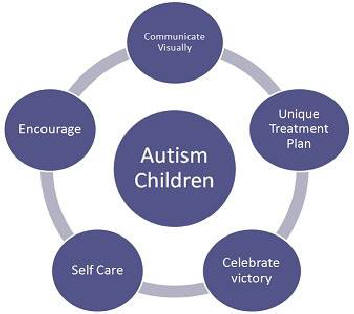Treatment

**Types of
Treatments**
Various
treatment approaches for ASD can be categorized as follows:
-
**Behavioral**: Focuses on changing behaviors by understanding what
influences them. Applied Behavior Analysis (ABA) is a prominent
behavioral treatment, utilizing methods like Discrete Trial Training
(DTT) and Pivotal Response Training (PRT). DTT involves step-by-step
teaching and rewards positive behaviors, while PRT occurs in natural
settings, emphasizing pivotal skills that facilitate learning.

-
**Developmental**: Targets specific developmental skills, often in
conjunction with behavioral approaches. Key therapies include:
- **Speech and Language Therapy**: Enhances
communication skills.
- **Occupational Therapy**: Aids in
independent living skills and may include sensory integration therapy
and physical therapy.
- **Early Start Denver Model (ESDM)**:
Combines ABA principles for children 12–48 months, focusing on social
exchanges and play to boost language and social skills.
**Other
Approaches**: Treatments can include educational, social-relational,
pharmacological, psychological, and complementary methods.
**Educational Approaches**: One notable educational method is the TEACCH
approach, which emphasizes consistency and visual learning for
individuals with autism. It encourages teachers to structure classrooms
effectively, using visual schedules and physical demonstrations to
enhance learning.
**Social-Relational Approaches**: These treatments aim to improve social
skills and emotional connections, often involving parents or peer
mentors. Models like the DIR ("Floor Time") follow individual interests
to foster communication, while the RDI model enhances motivation and
participation in social interactions. Social Stories outline
expectations in various situations, and social skills groups offer
practice in a structured setting.
**Pharmacological Approaches**:
Some
medications can help manage co-occurring symptoms of Autism Spectrum
Disorder (ASD) and improve functioning. They may address issues like
high energy levels, difficulty focusing, or self-harming behaviors, as
well as co-occurring conditions such as anxiety, depression, seizures,
or sleep problems. It’s essential to work with a doctor experienced in
treating ASD to carefully monitor progress and side effects.
Psychological approaches, like cognitive-behavioral therapy (CBT), can
help individuals with ASD cope with mental health issues by changing
their thought patterns and reactions to various situations.
Additionally, some families explore complementary and alternative
treatments, such as special diets, herbal supplements, or therapy (like
animal or arts therapy). It's crucial to consult a doctor before
starting any of these treatments.